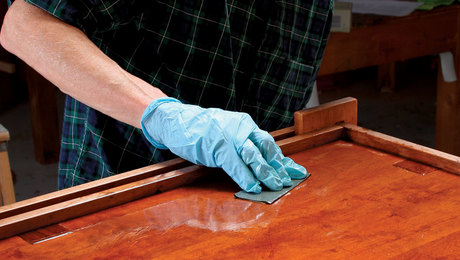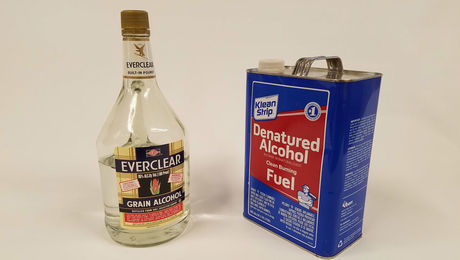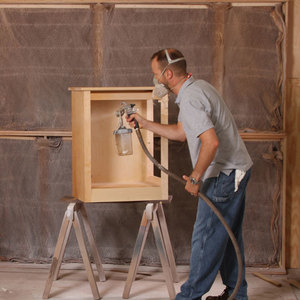Q&A: Mineral spirits vs. paint thinner vs. turpentine vs. naphtha
Everything you always wanted to know about solvents but were afraid to ask.
Solvents can be incredibly confusing and the most common point of confusion is paint thinner vs. mineral spirits. To many, mineral spirits and paint thinner are interchangeable—both in function and by name. You’ll often see “made with mineral spirits” or “100% mineral spirits” on the paint thinner can. Simply put, mineral spirits and paint thinner start out the same, but the solvent in a can of mineral spirits is more refined than what’s in a can of paint thinner. This added refinement equates to fewer extraneous compounds and less odor. Both will clean a brush after using an oil-based varnish, but if you need to thin out a finish, ironically you’re better off staying away from paint thinner and using mineral spirits (or better yet VM&P naphtha*).
Mineral spirits or paint thinner?
If we’re going to get more specific, look at the safety data sheet for Kleen Strips “Odorless mineral spirits” and their “Paint thinner.” Both list “hydrotreated light distillate (petroleum, mineral spirits)” as the only chemical component. In Fine Woodworking #41, George Mustoe goes a little deeper: “Mineral spirits are distilled from petroleum, and consist mostly of the aliphatic hydrocarbons hexane, heptane, and octane. Composition varies according to the source of the crude oil and manufacturing differences from batch to batch, and chemical analysis reveals the presence of as many as 100 separate compounds in some samples.”
Mineral spirits are grouped into three categories.
- Odorless spirits consist mostly of aliphatic compounds with fast evaporation rates and relatively weak solvency.
- Low odor spirits are predominantly heptane and octane fortified with small amounts of xylene and toluene.
- Regular odor mineral spirits comprise about 75% of all solvents used in the paint industry. They consist of 15% to 25% aromatic hydrocarbons.
Mustoe writes, “Mineral spirits are less toxic than most other solvents, but vapors can cause skin and respiratory irritation and CNS toxicity increases in proportion to the aromatic hydrocarbon content, so odorless spirits are best for general use.”
While most woodworkers might go through only a quart of mineral spirits or paint thinner every few years, it’s still best to limit your exposure to chemicals. If the cost of doing so is a few dollars, you might find that’s money well spent.
Where does *VM&P naphtha fit into the equation?
Sometimes referred to as “white gas” if you can find it, VM&P (varnish makers and painters) naphtha is likely your best friend when thinning oil-based finishes. Composed of hydrotreated light naphtha, yet another petroleum distillate (what isn’t these days?), VM&P naphtha is functionally similar to mineral spirits, but is, yet again, more refined and has a faster drying time. Adding naphtha into your finishing cabinet will give you a less caustic cleaning product for dewaxing and degreasing and gives you more options if you need faster drying solvent for your oil-based finishes.
Michael Mascelli put it in his video workshop, Staining and Dyeing Wood:
“Think about mineral spirits as regular gas. Naphtha is premium gas. They’re both petroleum distillates, [but naphtha] is a much cleaner, smoother, easier way to work with oil based [products]. It’s only a dollar or two more, and I highly recommend it.”
Naphtha is not available everywhere. I don’t know why, but I have found it difficult to purchase in Connecticut and when I need it I purchase from out of state. One exception: It is often available at my local Woodcraft in Manchester, Conn.
Below, we’ve gathered some Q&A from scientists and woodworkers alike, featured in past issues, that give more detail on the topic.
Mineral spirits or turpentine as a thinner?
I use a mixture of polyurethane varnish, tung oil, and thinner for most of my finishing. I have always used the cheapest thinner I can find. Is there anything wrong with that? What would be the benefit of using a more expensive brand of thinner or even turpentine? Kerosene is still less expensive than mineral spirits. Would it be all right to use it as a thinner for my varnish?
—Ernst Kallenbach, Gainesville, Fla.
Chris Minick replies: Oil-based varnishes are very forgiving finishes. They will tolerate just about any petroleum-based thinner, mineral spirits, paint thinner, VM&P naphtha, kerosene, turpentine, and even alcohol. However, oil-based varnishes are designed to work best when mineral spirits are used for thinning. Substituting an alternate thinner will significantly affect the drying time and application properties of a finish. For instance, kerosene evaporates about three times slower than mineral spirits and will significantly delay drying time. Kerosene also has a lower “solvent power,” which affects flow out of the finish. Worse yet, the wrong thinner may even compromise the ultimate durability of the dry finish film. Turpentine often contains dissolved rosin. Rosin, even in small amounts, will decrease both hardness and durability of the dry varnish film. My advice is to stick with mineral spirits. Better to pay a few dollars more for thinner than to screw up a project that took weeks to build.
Chris Minick is a finish chemist. Q&A featured in Fine Woodworking #136
Is turpentine safer?
Is turpentine safer for a worker’s health than mineral spirits?
—Gregg Aanes, Bellingham, Wash.
Beau Belajonas replies: You should be careful with any solvent, no matter how safe you think it is. Provide adequate ventilation, avoid excessive skin contact, and wear whatever respirator might be recommended by the manufacturer. Turpentine is the distilled resinous sap found in pine trees in the southeastern United States. Pure gum spirits of turpentine, the only grade you should use for paint or varnish, has an agreeable odor, its vapor is relatively non-irritating, and it’s one of the safest solvents in terms of fire risks. Mineral spirits are distilled from petroleum oils, and as a thinner this mixture has properties similar to turpentine. It also has several advantages over turpentine. It leaves no sticky, gummy residue, it does not deteriorate with age, its cost is a small fraction of the price of gum turpentine, and it’s less likely to affect people with allergic reactions. In indoor work, where solvent fumes and odors are rather concentrated, mineral spirits are universally preferred.
Beau Belajonas is a professional wood finisher in Camden, Maine. Q&A featured in Fine Woodworking #136
Naphtha is best for cleaning oily wood
I want to repair the mortise-and-tenon joints on a small teak end table. The glue in the joints is no longer holding them together. I know teak is an oily wood, which makes it difficult to achieve successful glue joints. Should I use a solvent to degrease the teak before gluing it, and if so, what kind should I use?
—H. William Angevine, Appleton, Wis.
George Mustoe replies: Wiping the joints with a solvent to remove some of the surface oils before the glue-up can be very effective in increasing bond strength. Of the possible solvents that would work, naphtha is probably the most effective and the least toxic. Ordinary mineral spirits are less effective than naphtha, but the liquid has the best safety record among common shop solvents. Lacquer thinner will also work, but it’s more toxic and thus requires good ventilation and an organic vapor respirator.
George Mustoe is a geochemistry research technician at Western Washington University in Bellingham, Wash. Q&A featured in Fine Woodworking #72
Best solvents for removing a wax finish
In my refinishing business, I occasionally need to lacquer a piece of furniture that has a wax finish already on it. Is there any way of removing the wax without stripping and sanding the entire piece so a new coat of lacquer can be applied?
—Dave Hewlett, Bellingham, Wash.
Bob Flexner replies: You can remove wax from furniture by washing the surface thoroughly with a solvent, such as mineral spirits or naphtha. If the wax was applied originally over a sealed surface, then it will come off easily, because it hasn’t entered the wood’s pores. If the wax was applied to raw wood, it will be more difficult to remove, but here is what to do: Wearing rubber gloves, take a folded cloth soaked with one of the solvents and wet the surface thoroughly. Then begin drying it off, refolding the cloth continuously so that the dissolved wax is picked up on a clean part of the cloth and not just spread around. Repeat this procedure several times, using fresh cloths as needed. Then let the surface dry and examine it for traces of wax—a shininess in the pores or a waxy feel. If you think the surface is clean, wash it one more time to be safe. You can also apply regular paint and varnish remover, which is a more powerful solvent for wax. Rub it off with paper towels as described above, then wash the surface with mineral spirits or naphtha. Let the wood dry overnight, to give all the solvent time to evaporate. Because no water has been used to remove the wax, there should be no raising of the grain and therefore no need to sand the surface. If you intend to lacquer or varnish the piece, seal it first with a coat of shellac, which will act as a barrier between any minute quantities of remaining wax and the new finish. Treat the shellac just as you would a sanding sealer, scuffing it lightly with fine sandpaper to smooth it before finishing.
Bob Flexner is a professional finisher and restorer in Norman, Okla. Q&A featured in Fine Woodworking #136
 |
How to Revive a Finish |
 |
Shellac solvent: grain alcohol vs. denatured alcohol |
 |
From the archive: All About thinning finishes |
Fine Woodworking Recommended Products

Bahco 6-Inch Card Scraper

Diablo ‘SandNet’ Sanding Discs























Comments
In the 70's and 80's I used a lot of products made by Dean & Berry (no longer in business). Partly because the store owner knew a lot about how to get the best results out of what he had and also because they had a line of numbered thinners that dried at different speeds. Number 33 was good for general use but if you were finishing an exterior door late in the after noon and you wanted it to dry before it was covered with bugs (or dust nubs for woodworkers) number 44 was a good choice. There were some that dried faster than 44 but hard to brush on a large surface without lap marks. I really miss having a dealer that has a line of products that will do everything and someone that knows what is best for any situation.
Be safe, wear a mask and have fun.
Ben. This was very informative. Thanks. I’ve always had some confusion about the products mentioned here. My selection of finishes is often based on the weather. When good ventilation is not possible I tend to go toward Tried and True oils. When I can ventilate I’ll add in some poly and spirits which is my go to for all table tops. After reading your article, naphtha seems something worth exploring. Thanks again
Joe Zuaro
Thank you, Ben. Very informative How-to. I would like to build on this with a you should consider before use. The flashpoints of products you are using and the toxicity levels. Your safety is your own responsibility. A solvent product that was removed from the general consumer market some time ago was called Benzene. Bone and pancreatic cancer were two reasons. This is still in use today. Every time you put gasoline in a car, it is what you smell.
Log in or create an account to post a comment.
Sign up Log in